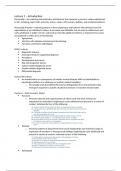Lecture 1 – Introduction
Personality = the enduring characteristics and behavior that comprise a person’s unique adjustment
to life, including major traits, interests, drives, values, self-concept, abilities, and emotional patterns.
Personality disorder = enduring pattern of inner experience and behavior that deviates from the
expectations of an individual’s culture, is pervasive and inflexible, has an onset in adolescence and
early adulthood, is stable over tie, and leads to clinically significant distress or impairment in social,
occupational or other areas of functioning.
Egosyntonic
Interfere with adaptive interpersonal functioning.
Pervasive, persistent, pathological
DSM-5 criteria
Diagnostic features
Associated features supporting diagnosis
Prevalence
Development and course
Risk and prognostic factors
Culture-related diagnostic issues
Gender-related diagnostic issues
Differential diagnosis
General PD criteria
No manifestation or consequence of another mental disorder AND not attributable to
physiological effects of a substance or another medical condition.
o Personality traits that define PD must be distinguished from characteristics that
emerge in response to specific situational stressors or transient mental states
Cluster A – Odd, Eccentric, Weird
Paranoid
o Pervasive distrust and suspiciousness of others such that their motives are
interpreted as malevolent, beginning in early adulthood and present in a variety of
context. Indicated by four of the following:
Schizoid
o Pervasive pattern of detachment form social relationships and restricted range of
expression of emotions in interpersonal settings, beginning by early adulthood and
present in variety of context. Indicated by four of the following:
Schizotypal
, o Pervasive pattern of social and interpersonal deficits marked by acute discomfort
with, and reduced capacity for, close relationships as well as by cognitive or
perceptual distortions and eccentricities of behavior, beginning by early adulthood
and present in a variety of contexts. Indicated by five of the following:
Cluster B – Dramatic, Emotional unpredictable, Wild
Antisocial
o Pervasive pattern of disregard for and violation of the rights of others, occurring
since age 15 years. Indicated by three of the following:
Borderline
o Pervasive of instability of interpersonal relationships, self-image, and affects, and
marked impulsivity beginning in early adulthood and present in a variety of contexts.
Indicated by five of the following:
Histrionic
o Pervasive pattern of excessive emotionality and attention seeking, beginning by early
adulthood and present in a variety of contexts. Indicated by five of the following:
Narcissistic
o Pervasive pattern of grandiosity, need for admiration, and lack of empathy,
beginning by early adulthood and present in a variety of contexts. Indicated by five of
the following:
,Cluster C – Anxious, Fearful, Worried
Avoidant
o Pervasive pattern of social inhibition, feelings of inadequacy, and hypersensitivity to
negative evaluations, beginning by early adulthood and present in a variety of
contexts. Indicated by four of the following:
Dependent
o Pervasive and excessive need to be taken care of that leads to submissive and
clinging behavior and fears of separation, beginning by early adulthood and present
in variety of contexts. Indicated by five of the following:
Obsessive-Compulsive
o Pervasive pattern of preoccupation with orderliness, perfectionism, and mental and
interpersonal control, at the expense of flexibility, openness, and efficiency,
beginning by early adulthood and present in a variety context. Indicated by four of
the following:
Primary propositions alternative model
Problems with present PD diagnosis system
, Limited empirical evidence for validity for some existing PD types
Lack of specificity in general definition PDs
Inadequate representation of PD severity
Heterogeneity within types and arbitrary thresholds for diagnosis
Behavioral oriented criteria
Comorbidity among PDs and with clinical disorders
The majority of people has two or more PD diagnoses
The PDNOS category is used very often in clinical practice
High comorbidity of other clinical disorders
Stability of PDs
PDs start early and are chronic
o Certain threshold for symptoms
Point prevalence = measure of proportion of people in a population who have a condition at
a particular time/date.
Lifetime prevalence = proportion of individuals in a population that at some point in their life
have experienced a condition.
We would expect the lifetime and point prevalence to be relatively similar for PDs however,
lifetime prevalence of PDs is on average 3x higher than point prevalence.
Conclusion
o People seem to possess relatively stable (maladaptive) personality traits that
underlie symptoms of problematic self-to-self-relating and interpersonal functioning.
Under periods of life stress these traits and daily functioning might become more






